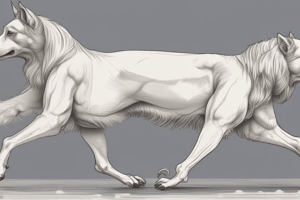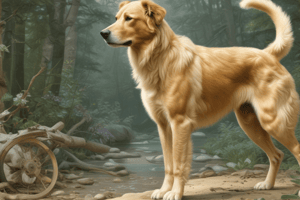Podcast
Questions and Answers
What is the primary reason dogs sniff other dogs' rear ends?
What is the primary reason dogs sniff other dogs' rear ends?
- To greet each other in a friendly manner
- To mark their territory
- To collect chemical information about the other dog (correct)
- To establish dominance
Which of the following factors influences how a dog ages?
Which of the following factors influences how a dog ages?
- The dog's breed
- The dog's size
- The dog's diet
- All of the above (correct)
What is the scientific name of a dog?
What is the scientific name of a dog?
- Canis lupus familiaris (correct)
- Canis lupus
- Canis familiaris
- Felis catus
What is the primary reason why dogs bark?
What is the primary reason why dogs bark?
Which of the following breeds is known for its unique aging rate?
Which of the following breeds is known for its unique aging rate?
Which of the following vaccines is given to dogs at three months old?
Which of the following vaccines is given to dogs at three months old?
What is the primary reason for creating Labradoodles?
What is the primary reason for creating Labradoodles?
Which of the following is NOT true about dogs?
Which of the following is NOT true about dogs?
What is the oldest ancestor of modern-day dogs?
What is the oldest ancestor of modern-day dogs?
Which of the following is NOT a direct descendant of Tomarctus?
Which of the following is NOT a direct descendant of Tomarctus?
Which genetic evidence suggests the location of dog domestication?
Which genetic evidence suggests the location of dog domestication?
What does the content suggest about dog domestication being a single event?
What does the content suggest about dog domestication being a single event?
What is the most likely reason wolves may have facilitated their own domestication?
What is the most likely reason wolves may have facilitated their own domestication?
Which of the following is NOT supported by genetic evidence concerning the arrival of dogs in the Americas?
Which of the following is NOT supported by genetic evidence concerning the arrival of dogs in the Americas?
What is a unique characteristic of canids compared to bears?
What is a unique characteristic of canids compared to bears?
Which of the following is NOT a type of dog that existed by the beginning of the Bronze Age?
Which of the following is NOT a type of dog that existed by the beginning of the Bronze Age?
How does the content portray the role of dogs in different cultures?
How does the content portray the role of dogs in different cultures?
Which of the following statements best describes the relationship between humans and dogs?
Which of the following statements best describes the relationship between humans and dogs?
Flashcards
Labradoodle
Labradoodle
A crossbreed of a Labrador Retriever and a Poodle.
Dog Barking
Dog Barking
A form of communication for dogs, signaling various emotions.
Chemical Information
Chemical Information
Data gathered by dogs through sniffing each other's rear ends.
Dog Years Calculation
Dog Years Calculation
Signup and view all the flashcards
Vaccination Schedule
Vaccination Schedule
Signup and view all the flashcards
Scientific Name of Dog
Scientific Name of Dog
Signup and view all the flashcards
Domestication of Dogs
Domestication of Dogs
Signup and view all the flashcards
Ubiquitous Animals
Ubiquitous Animals
Signup and view all the flashcards
Chihuahua
Chihuahua
Signup and view all the flashcards
Irish Wolfhound
Irish Wolfhound
Signup and view all the flashcards
Dog domestication
Dog domestication
Signup and view all the flashcards
Miacis
Miacis
Signup and view all the flashcards
Cynodictis
Cynodictis
Signup and view all the flashcards
Tomarctus
Tomarctus
Signup and view all the flashcards
Canis
Canis
Signup and view all the flashcards
Common characteristics of canids
Common characteristics of canids
Signup and view all the flashcards
Dog breeds by Bronze Age
Dog breeds by Bronze Age
Signup and view all the flashcards
Homeothermic
Homeothermic
Signup and view all the flashcards
Study Notes
Dog Characteristics and Evolution
- Dogs are domestic mammals of the Canidae family, order Carnivora. Their scientific name is Canis lupus familiaris.
- They are a subspecies of the gray wolf (Canis lupus) and related to foxes and jackals.
- Dogs are one of the two most common and popular domestic animals.
- Dogs' sizes range significantly, from the small Chihuahua (5-8 inches) to the large Irish Wolfhound (30+ inches).
- Dogs' roles and value vary across cultures.
- Dogs' roles range from hunting companions and protectors to beasts of burden, guards, and even food in certain parts of the world; in other areas, they are highly valued.
Dog Communication and Behaviour
- Dogs bark to communicate with other dogs and humans.
- Barking can signal territoriality, threat, or a desire for attention.
- Sniffing other dogs' rear ends helps dogs gather chemical information regarding identity, genetics, reproductive status, diet, and emotional state.
- Specialized scent glands on either side of their anus provide unique scent profiles.
Dog Health and Vaccination
- Dogs receive a series of four combined vaccines (distemper, hepatitis, parainfluenza, and parvovirus) starting at six weeks old, with booster shots at one year and then every three years.
- Dogs get a rabies vaccine at three months old, and boosters are given yearly or every three years, depending on the schedule.
Dog Ageing
- Dog years aren't a simple multiple of human years; their aging depends on size and breed.
- Small dogs typically age more slowly than large ones.
- Some breeds, like beagles, may have a different aging rate than others of a similar size.
Dog History and Origin
- Dogs evolved from the genus Miacis.
- Cynodictis was an early, true dog-like ancestor.
- Tomarctus from the Eurasian branch of Cynodictis is the progenitor of wolves, dogs, and foxes.
- Genetic evidence suggests that dogs descended from wolves.
- Domestication wasn't a single event but a process occurring thousands of years ago in northern Eurasia.
- Dogs likely facilitated their own domestication by foraging on leftover game animals.
- Early domestication events may have occurred in different regions of Eurasia, with dogs and wolves interbreeding.
- Some genetic studies suggest initial domestication events for livestock purposes in China (16,300 years ago) or with a smaller wolf strain in India (12,000-14,000 years ago).
- Dogs arrived in the Americas around 10,000 years ago, not with the first humans.
- Some African breeds might have descended from jackals, not wolves.
Canine Anatomy and Physiology
- Dogs are mammals that bear live young, and have mammary glands for suckling.
- Early dog breeds had erect ears and pointed/wedge-shaped muzzles.
- Dogs and other carnivores share similar dental structures.
- Dogs develop two sets of teeth: deciduous ("baby") and permanent.
- Dogs are homeothermic (have an internal thermostat), and walk on their toes rather than flat-footed.
Types Of Dogs (Fossil Record)
- By the Bronze Age (about 4500 BCE), five distinct types of dogs existed: mastiffs, wolf-type dogs, sight hounds (e.g., Saluki, greyhound), pointing dogs, and herding dogs.
Studying That Suits You
Use AI to generate personalized quizzes and flashcards to suit your learning preferences.



